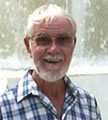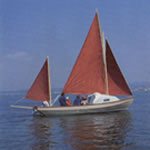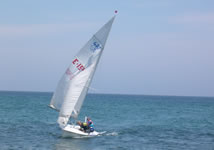News Feature
Santa Irene Club de Vela - Sharing a lifelong passion
By Nathalie Jones
 A man with a passion, an expression which undoubtedly
applies to John Talliss, the president of the Santa Irene Club de Vela. But
John’s passion for sailing is by no means a selfish one; rather it’s
something he’s invested a huge amount of his time and effort, not to mention
money, in sharing with others.
A man with a passion, an expression which undoubtedly
applies to John Talliss, the president of the Santa Irene Club de Vela. But
John’s passion for sailing is by no means a selfish one; rather it’s
something he’s invested a huge amount of his time and effort, not to mention
money, in sharing with others.
When John first decided to found the Mojácar Playa-based dinghy sailing
club back in 2000, his main aim was to bring the sport to local youth. And after
a pretty painful process of acquiring all the relevant approvals and paperwork,
and with the invaluable help and support of Sharon Penfold and her family, his
idea became a reality in June 2002.
Santa Irene Club de Vela is today a Registered Sports Club of Andalucía and a member of the Andalucían Sailing Federation, as well as a member of the Drascombe Association, the Royal Yachting Association and the Polynesian Catamaran Association. And every Sunday at the Playa del Cantal beach in front of Mr UK, novices can learn all about how to handle a boat and experienced sailing enthusiasts have the opportunity to get out on the water.
 The club is well equipped to cater for all levels
of experience. Dinghy classes sailing at the club are: Optimist, Topper, Mirror,
Lark and 470. Catamarans are: a 10ft Kidkat, Hobie 13, 14 and 16 and a Nacra
5 metre. The club also has a sail training boat (the Pasinaca), a traditional
6.6m Yawl Drascombe Longboat cruiser - "Dos Amigos" - in which John and club
member Terry plan to visit other clubs to spread the word about Santa Irene.
There are even two sailboarders for those who enjoy the thrill of windsurfing.
Seaside resorts such as Mojácar would seem the obvious base for a sailing club,
but what are the sailing conditions like? John told Levante Lifestyle: "The
conditions are a little hard sometimes because it can change very rapidly, but
we get as many forecasts as we can from as many sources as we can, and have
to make decisions as to whether to sail or not. There are times when it isn't
convenient to sail, but dinghy sailing is normally kept to a fairly confined
area, so we're not talking about going miles off shore, and we do have a safety
boat.
The club is well equipped to cater for all levels
of experience. Dinghy classes sailing at the club are: Optimist, Topper, Mirror,
Lark and 470. Catamarans are: a 10ft Kidkat, Hobie 13, 14 and 16 and a Nacra
5 metre. The club also has a sail training boat (the Pasinaca), a traditional
6.6m Yawl Drascombe Longboat cruiser - "Dos Amigos" - in which John and club
member Terry plan to visit other clubs to spread the word about Santa Irene.
There are even two sailboarders for those who enjoy the thrill of windsurfing.
Seaside resorts such as Mojácar would seem the obvious base for a sailing club,
but what are the sailing conditions like? John told Levante Lifestyle: "The
conditions are a little hard sometimes because it can change very rapidly, but
we get as many forecasts as we can from as many sources as we can, and have
to make decisions as to whether to sail or not. There are times when it isn't
convenient to sail, but dinghy sailing is normally kept to a fairly confined
area, so we're not talking about going miles off shore, and we do have a safety
boat.
“Also, we live somewhere where the weather and
temperatures are much, much better than in the UK, where most clubs curtail
things quite a bit in the winter. While the winter months here can in many ways
be better than the summer months.”
These days John shares the responsibility of running Santa Irene Club de Vela
with the other committee members, but despite his 76 years he’s just as
active as ever, and is constantly building contacts with other sailing clubs
or working on new plans and ideas. One of the projects he’s currently
focused on is his proposal of using the boating lake constructed in Cuevas del
Almanzora for the 2005 Mediterranan Games rowing and canoeing trials for training
total sailing novices.
 “We’ve already spoken to the sports councillor
in Cuevas and there is a possibility of creating something there after the games.
That would be ideal to start complete beginners from the age of eight. I only
hope someone will listen to us”, John commented.
“We’ve already spoken to the sports councillor
in Cuevas and there is a possibility of creating something there after the games.
That would be ideal to start complete beginners from the age of eight. I only
hope someone will listen to us”, John commented.
We hope that dinghy racing Olympic gold medallist and Mediterranean Games ambassador,
Teresa Zabell will be able to lend her support to the idea which just may just
help swing the balance in favour of the proposal among local authorities.
Then there is the club’s ongoing problem of finding a permanent location
from which to sail; in the peak summer months Playa del Cantal becomes too crowded
to operate from, plus there is nowhere to store all the club’s boats and
equipment.
“We do have an application in for somewhere permanent on the Playa, and
we shall wait and see”, John said, adding in respect to why he thinks
the club should be supported by local authorities, and even the Junta de Andalucía:
“It’s another sport, another activity.”
In the meantime John regrets the fact the club is not attracting more teenagers,
and that the club’s facilities can’t compare with those offered
by the sailing club in Almería city for example, but he adds: “That
could come. I realised it wouldn’t be easy simply because we hadn’t
the sheltered water to launch from, which you would get if and when a marina
is built here.”
On a more personal level, John explained he had named the sailing club in memory
of his late wife and “first mate”, Ethel Irene. The name had seemed
doubly appropriate when John discovered Santa Irene was, as his wife had been,
the youngest of three sisters, and had become a saint (the Patron Saint of Peace)
as a teenager, fitting in with John’s initial ideas of setting up a club
for young people.
But how did a born and bred brummie like John become
so mad about sailing; after all you can’t get much further away from the
sea in Britain than Birmingham! John said he had developed an interest in boats
from an early age thanks to family holidays in Weymouth, and even though there
was a tradition of joining the RAF in his family, he joined the navy at the
age of 18, and it was at this time that he learned to sail on 27-foot ‘whalers’.
In the 1950s John began racing dinghies with his brother, a sport he kept up
for around 25 years, even competing in national championships. “It was
a very serious sport for me and my brother, but sadly my brother died young
in 1973, and my racing dinghies more or less came to a stop then. Then I bought
a small Southerly 28 cruising boat which I kept at Poole in Dorset, and my wife
and I became cruising sailors.”
When John and his wife moved to Mojácar 20
years ago he’d pretty well stopped sailing, not least because there was
little in the way of opportunity to get out on the water: “Mojácar
was a quiet area with a community which had no spare money to buy boats with,
certainly. They would buy fishing boats, but they weren’t sailing as a
sport.”
So why did John go to so much effort to set up a sailing club in Mojácar,
with all the hassle, work and expense which went with it; why not just concentrate
on sailing himself?: “We had no family and I wanted to leave something
behind, I wanted to do something for the local community. And sailing dinghies
is a sport that when a youngster gets involved, the nice thing is they can be
in a little boat all on their own, and they’re the captain of that boat,
and they’ve got to make all their own decisions. And that’s the
big thing from the youth point of view; they’re having fun, but they’re
learning all sorts of skills which you can apply in life in general and they’re
involved with the natural elements, and it all helps to create a better person.”
Finally, I asked John what for him is the real satisfaction in sailing: “When
you’re on the water, away from noise and traffic, the weather’s
right, you’ve harnessed the wind and everything’s great, well it’s
absolutely marvellous, it’s heaven!”
Santa Irene Club de Vela is for members only, although you don’t have to be a boat owner. Also membership is open to everyone,

